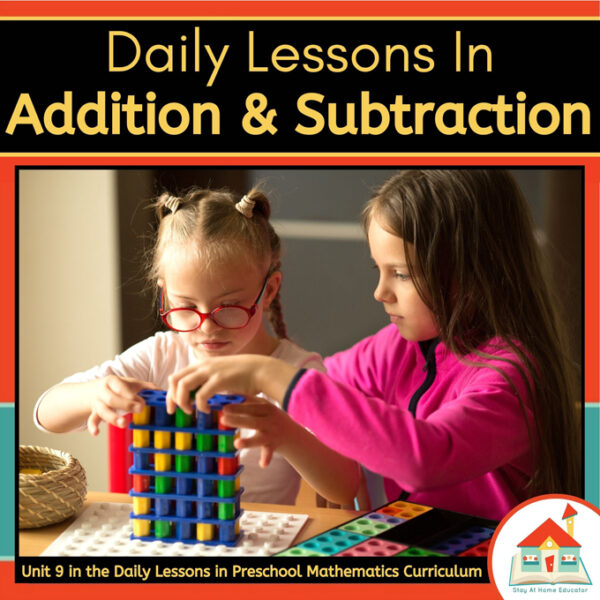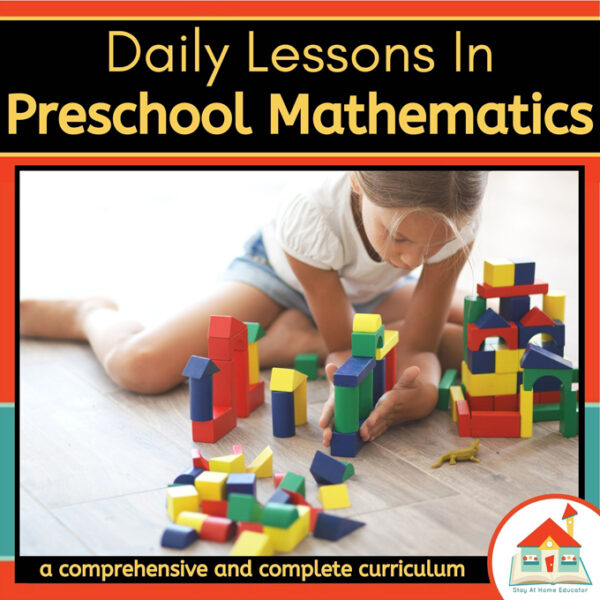In our ninth and final math lesson plans unit, we engage with preschoolers in learning simple addition and subtraction. Preschoolers begin to apply their number sense skills to join small groups together and practice taking away. It’s the perfect time to start teaching formal addition and subtraction principles.
Addition and Subtraction Activities for Preschoolers
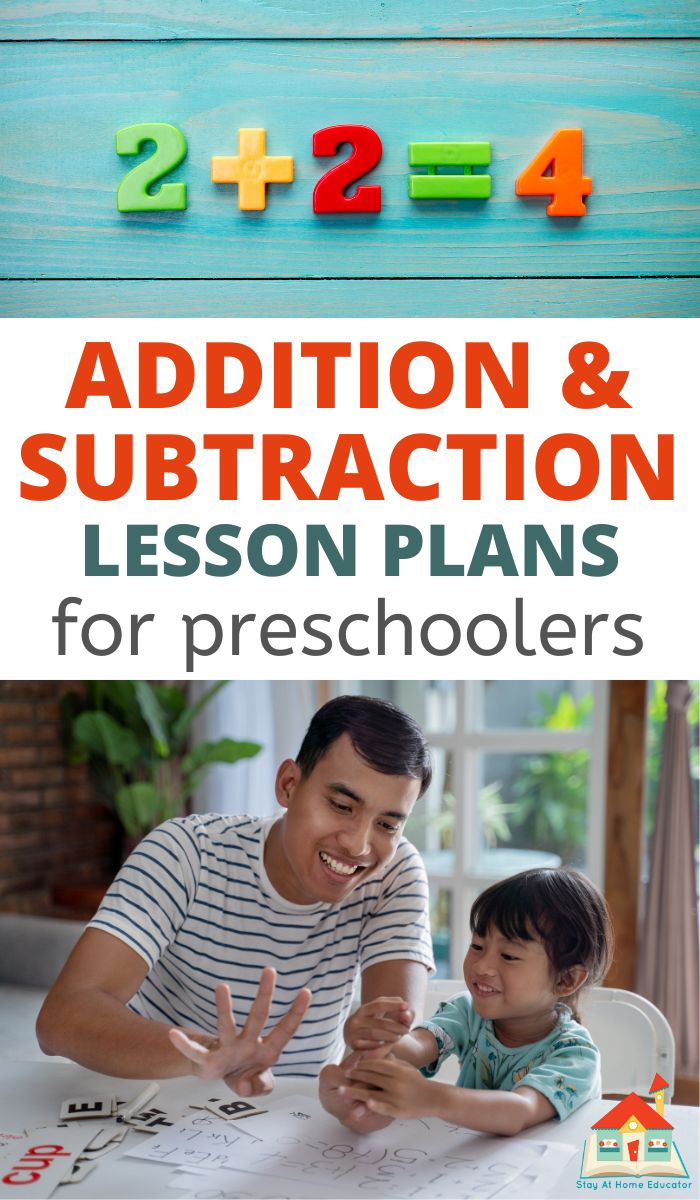
Our addition and subtraction lesson plans for preschoolers also include a detailed scope and sequence for the whole addition and subtraction unit, ensuring that teaching adding and subtracting, practicing number order, and building on number sense skills are the major focus for the whole unit.
Creating a preschool math curriculum was a heavy task! I knew when I began planning lessons, activities, and centers that I needed to make sure that the math skills of every single child were accounted for and that there were plenty of opportunities for differentiation.
I also knew it needed to spiral and review key concepts multiple times throughout the year, gradually increasing in difficulty. This approach is ideal because it covers math topics throughout the entire year. This allows children more time for mastery and an opportunity to increase the rigor of each lesson.
The Daily Lessons in Preschool Math curriculum was born out of that need and today we are focusing on the ninth and final unit in the series, Daily Lessons in Addition and Subtraction.
Maybe you are looking for addition lesson plans for preschoolers, or many subtraction too, this unit does a deep dive into age appropriate addition problems all while being interactive and fun!
Preschoolers are very capable of learning beginning addition and subtraction concepts. It’s developmentally appropriate for young children to practice joining small groups together or taking small groups apart.
Of course, in our previous counting lesson plan units, we reviewed teaching numbers 0-5, and numbers 0-10, and numbers 0-20. in the daily math lesson plans, lessons focused on a variety of number sense skills to prepare for addition and subtraction, such as:
- rote counting
- counting on
- one-to-one correspondence
- understanding of same, more, and less concepts
Plus, we must remember that addition and subtraction scenarios happen naturally during playtime and real life examples. A preschooler receives six animal crackers at snack time, eats one and learns that he now has five. He easily understands that he now has less because on was eaten (taken away).
These preschool addition and subtraction lesson plans are perfect for helping you plan engaging and developmentally appropriate lessons and activities for your students without loads of prep and time.
FAQ About Teaching Addition and Subtraction to Preschoolers
Simple addition and subtraction problems require children to learn how to break down math problems into smaller steps. It’s best to wait to use the traditional +/- symbols until children show understanding of the concept of simple addition/subtraction with manipulatives and through adding and subtracting stories.
While teaching preschoolers to add and subtract is developmentally appropriate, it’s important to begin with simple addition of just one more to help children understand how the quantity becomes larger when one item is added. Preschoolers must have well developed number sense skills before beginning addition and subtraction.
Be sure to read this post: The Ultimate Guide to Addition and Subtraction in Preschool.
Preschool lesson plans in addition and subtraction should include a wide range of age-appropriate joining and taking away practice.
Preschoolers are capable of learning more and less, increasing and decreasing quantities, number sequencing (order), composing within 5, decomposing within 5, composing within 10, and decomposing within 10 so those should all be included in a Preschool Addition and Subtraction Unit.
Related Reading
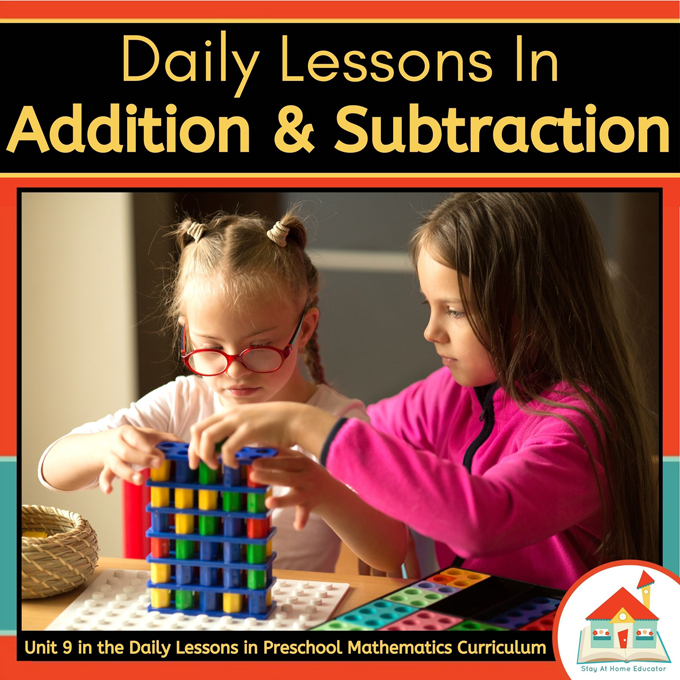
Addition and Subtraction Hands-On Supplies
This curriculum is designed to be low-prep and utilize the same supplies during each math unit. Buy it once, and use them over and over again for different learning purposes! Take a look at some of the resources we use for each unit and click each picture for more details. These items are staples for any early childhood math curriculum.
- PRACTICE COUNTING, SORTING & MORE: Develop early math skills, counting, sorting, and color…
- HANDS-ON TACTICAL LEARNING: These teddy bear counters are great for hands-on tactical learners.
- 102 BEAR COUNTERS WITH ACTIVITY GUIDE & STORAGE: Set includes 102 bear counters in 6 vivid colors,…
- COUNTING TOYS: Teach children to count to 100 by ones and tens while building fine motor and math…
- MATH LINK CUBES: 10 different kid-friendly colors, these cubes are terrific for grouping by color…
- CONNECT ON ALL SIDES: Cubes link together on all sides of each cube with circular cutouts so kids…
- Large Quantity: you will receive 150 pieces of large buttons for crafts, enough to meet your daily…
- Material and Size: these big buttons are made of plastic, bright and not easy to fade, providing you…
- Educational Toys: the craft buttons can help children practice distinguishing colors and shapes;…
- ATTRIBUTE BLOCK GEOMETRY SET: Our hand2mind attribute shapes come with a shape template and plastic…
- GREAT FOR PRESCHOOL ACTIVITIES: Our attribute blocks help teach early learners sorting, matching,…
- EARLY MATH MANIPULATIVES: Attribute blocks are key math manipulatives for young students in…
- A HANDY RESOURCE — Replace lost or broken board game spinners with these practical tools. Or,…
- MANY APPLICATIONS — Use Six Color Spinners to create your own games or make decisions. These write…
- SIX BRIGHT COLORS — Use the colored sections to help kids visualize probability and random events….
- Go For A Spin: Take these colorful arrows for a spin during your next game. These spinners are a…
- 5 Bright Colors: Outfit up to 4 players with red, yellow green, and blue spinners
- 12 Arrows Included: Each pack comes with 3 arrows in each of the 4 colors with classic pointed arrow…
All About Addition and Subtraction Preschool Lesson Plans
These addition and subtraction lesson plans for preschoolers are designed for up to a five-day-week program, but activities within a week can be removed and skipped for two or three-day-week programs.
The best part is that all the lesson ideas and activities included the use of manipulatives, gross motor movement, and lots of playful fun!
Discovery Activities/Math Photo Cards
The discovery activities are so much fun! Each week contains a real photograph or illustration for the children to interact with. The photo relates to the concept and encourages oral language and math vocabulary development. Plus, the vibrant photos expose children to different places, animals, and cultures. It’s easy to see that math really is everywhere in our daily lives!
The math photo card example below shows a gorgeous sunset with birds flying off in the distance. This engaging photo invites young learners to observe the picture very carefully and use clues in the photo to answer simple addition and subtraction questions. Each photo card includes mathematical points, teaching tips, and engaging questions to encourage your children to think about each photo through a mathematical lens.
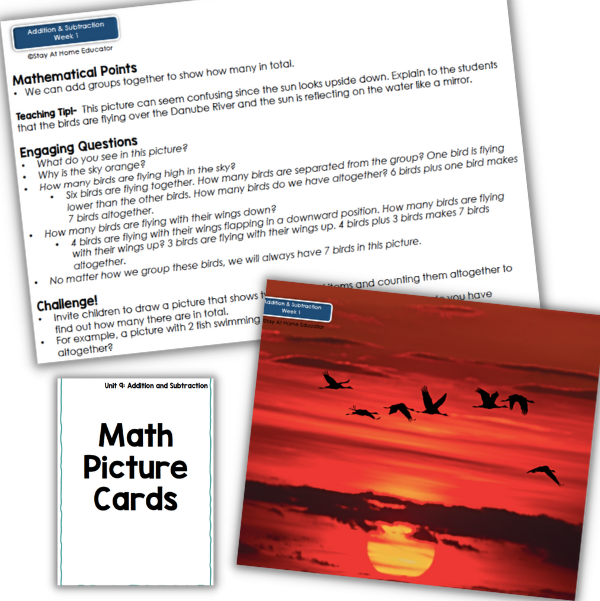
Daily Dip
The daily dip is a review activity to reinforce previously taught skills. You will notice valuable teaching tips throughout the review lessons. These tips offer insight to help execute specific strategies in
the lessons. This section is optional depending on time and student needs but is certainly a valuable component of each day.
The photo below shows examples of the first week of our preschool addition and subtraction lesson plans. Notice the activities include graphing themselves based on their opinions, practice with adding to a five frame, which was previously taught in previous units to ensure exposure and practice to essential math skills all year long.
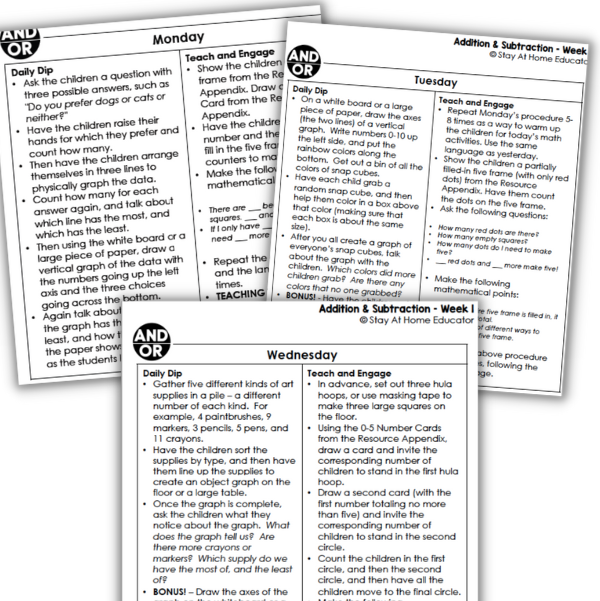
Teach and Engage
You’ll love the teach and engage section because it’s a brand new daily lesson for your students packed with new learning. This component of the curriculum includes lots of modeling and student interaction. Each lesson includes a bonus section that offers tips on how to make the lesson more challenging and provides extensions for children who are ready for more difficulty.
Addition and Subtraction Centers for Preschoolers
In these preschool addition and subtraction activities, we have included lots of hands-on addition activities and games that invite kids to develop and interact with adding and subtracting groups in numerous ways.
Many of the games and activities use engaging manipulatives such as snap cubes, colored counters, counting bears, and even playdough. Independent centers should always be supervised in preschool and kindergarten.
Composing Five, Composing Ten
This simple addition game is simple to prep and easy to play. Print out the cards and grab some counting bears. Then ask the child to choose a composing mat and identify the number on the left and add that many counters to cover. Then fill in the remaining spaces with counters. Invite your preschooler to find the yellow number card that matches how many we were added to compose five/ten.
This activity is all about the number combinations and early exposure to adding more to a set.
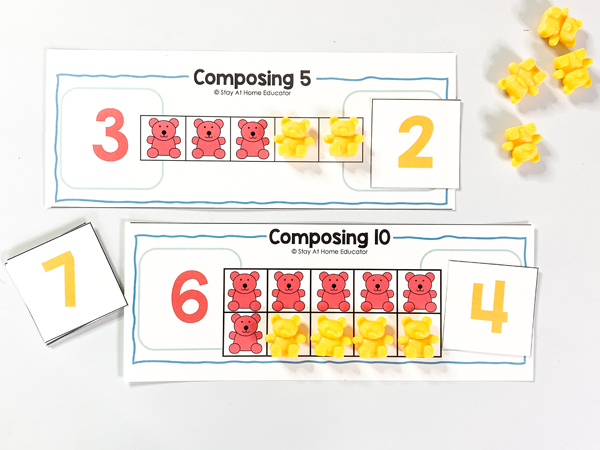
Ten Frame Addition
Ten frames are critical to building number sense and encouraging children to easily subitize. This ten-frame activity encourages children to combine groups to discover the total number or sum. Invite children to put counters on top of the top and bottom frames and count how many are on each frame. Then slide all those counters down to the bottom frame to determine how many counters there are all together.
This math center really helps preschoolers visualize “adding more” or composing numbers!
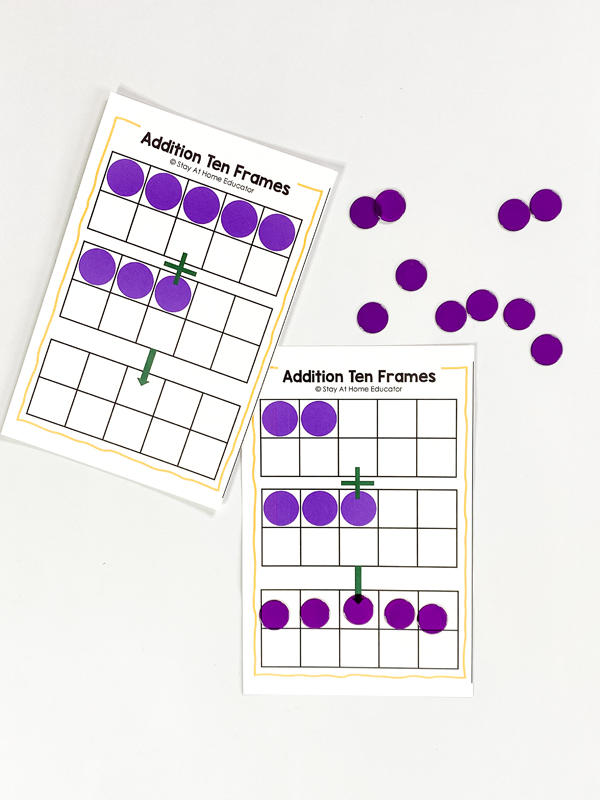
Watermelon Number Order Clip Cards
Who doesn’t love watermelon? This colorful math activity offers extra practice and the opportunity to develop number sense. Simply lay out the cards, grab some colored or plain clothespins, and invite your preschoolers to clip the correct number.
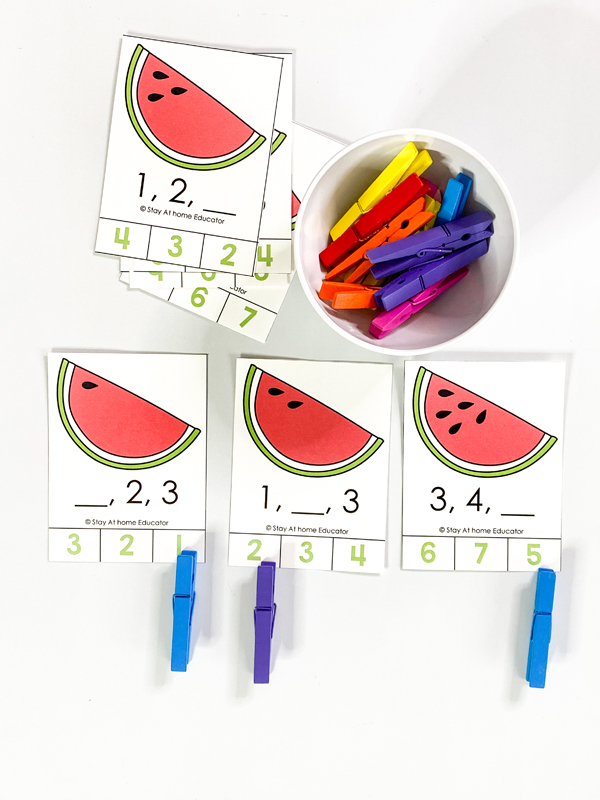
Snap Cube Number Order Task Cards
Everything is better with snap cubes! This fun task card activity is designed to help preschoolers count accurately, build one to one correspondence, and order numbers in ascending or descending order. After choosing a task card, the students will build a snap cube tower with that number of cubes. Then order their towers in ascending order.
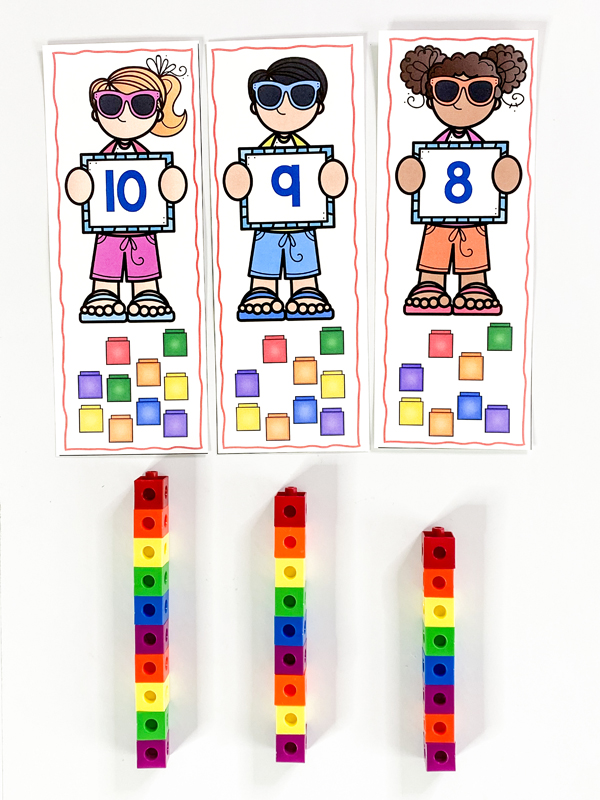
Playdough Ice Cream One More, One Less
Students will love this math center since it revolves around ice cream! Preschoolers will interact with a number line to find the number that is one less or one more than the number in the middle. Using playdough or dry erase markers, invite the children to make the ice cream scoops to match the numbers. These simple addition activities are perfect for introducing the concept of adding.
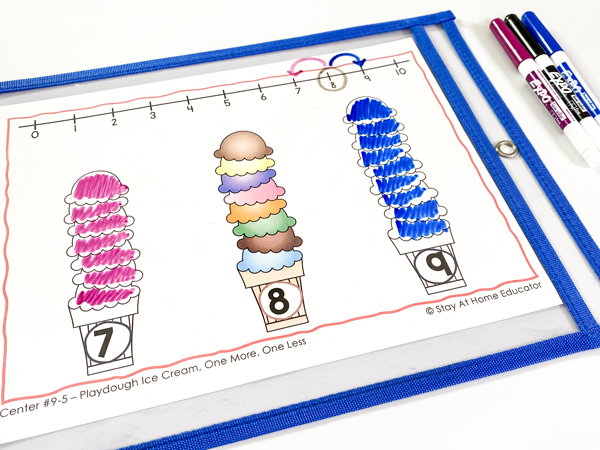
Zoo Animal One More, One Less
This fun animal-based math center focuses on simple addition and subtraction problems and introduces the plus, minus, and equal signs. The simple addition equation shows adding one more animal (a different animal to help discriminate the number) and what the correct answer looks like written out. The simple subtraction equation invites the students to cross out the one additional animal and read the equation with a peer or teacher.
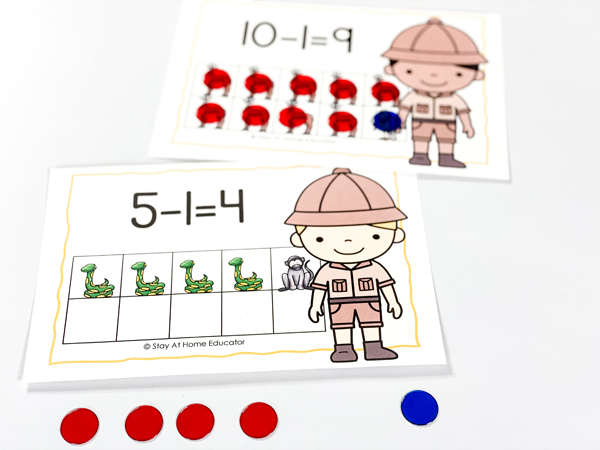
Ten Frame Subtraction Cards
This printable ten frame activity focuses on subtraction concepts. Children will place the total number of counters on the ten frame, then remove the corresponding number of counters shown by the numeral on the card. Then slide the remaining counters down to the bottom ten frame. It’s always helpful for a parent or teacher to use dialogue as it is happening.
For example, “I have ten counters, and then I take seven away, now I have three counters left. Ten counters take away seven counters is three.”
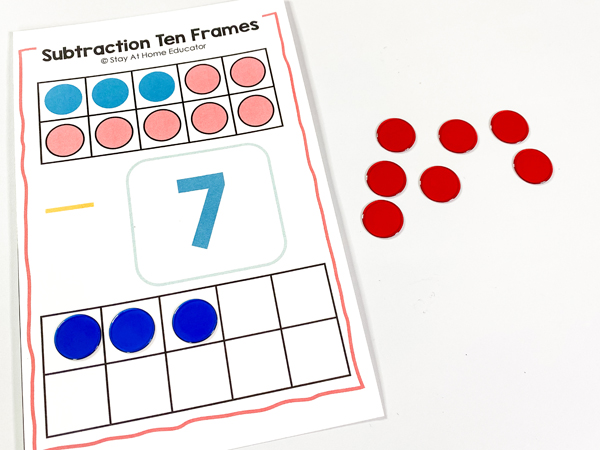
Roll and Add One; Subtract One
The goal of this dice game is to roll the dice, make the quantity rolled, and then add one more or take one away. You can see how our addition and subtraction math centers have gotten more rigorous for our preschoolers but still developmentally appropriate. Children can use any counters they like and then are tasked to circle the total number on the number line below.
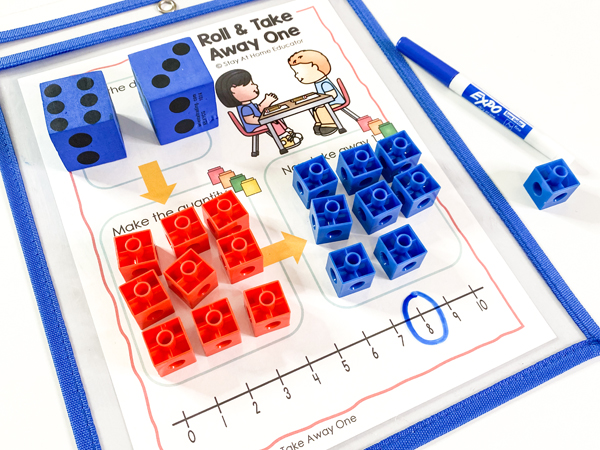
Math to Literacy Connections
We have also included eight optional literacy activities that infuse math picture books. Children learn best through colorful illustrations and storytelling. These eight picture books infuse simple addition and subtraction concepts, as well as, build upon other math skills (shapes, colors, patterns) as well. Click the book covers to read more about each book.
Grab these fantastic books about addition and subtraction here!
- Animals on Board by Stuart J. Murphy
- Fat Frogs on a Skinny Log by Sara Riches
- Domino Addition by Lynette Long
- Ten Red Apples by Pat Hutchison
- Quack and Count by Keith Baker
- Ten in the Bed by Penny Dale
- What’s New at the Zoo? by Suzanne Slade
- Jack the Builder by Stuart J. Murphy
- Monster Musical Chairs by Stuart J. Murphy
- Pete the Cat and His Four Groovy Buttons by Eric Litwin
- Elevator Magic by Stuart J. Murphy
- This award-winning series by Stuart J. Murphy teaches math through stories and visual models|63…
- Murphy, Stuart J. (Author)
- English (Publication Language)
- Sara Riches (Author)
- English (Publication Language)
- 32 Pages – 04/20/2024 (Publication Date) – Scholastic (Publisher)
- Long, Lynette (Author)
- English (Publication Language)
- 32 Pages – 02/01/1996 (Publication Date) – Charlesbridge (Publisher)
- Quack and Count By Baker Keith
- Baker, Keith (Author)
- English (Publication Language)
- Dale, Penny (Author)
- English (Publication Language)
- 24 Pages – 08/14/2007 (Publication Date) – Candlewick (Publisher)
- Used Book in Good Condition
- Suzanne Slade (Author)
- English (Publication Language)
- Murphy, Stuart J. (Author)
- English (Publication Language)
- 40 Pages – 02/28/2006 (Publication Date) – HarperCollins (Publisher)
- Murphy, Stuart J. (Author)
- English (Publication Language)
- 40 Pages – 08/22/2000 (Publication Date) – HarperCollins (Publisher)
- Hardcover Book
- Litwin, Eric (Author)
- English (Publication Language)
- Murphy, Stuart J. (Author)
- English (Publication Language)
- 40 Pages – 09/01/1997 (Publication Date) – HarperCollins (Publisher)
Get Your Addition and Subtraction Lesson Plans for Preschoolers Here
The Daily Lessons in Addition and Subtraction are complete and ready to use!
These adding and subtracting preschool lesson plans include daily lessons, centers, activities, and even literacy connections. This addition and subtraction math unit is all you’ll need to teach simple addition and subtraction, one more/one less, and develop foundational number sense skills with your preschoolers.
Math Lesson Plans for Preschoolers
Creating a comprehensive math lesson plan for preschoolers requires careful consideration and planning. A full math curriculum should encompass all five disciplines in mathematics: number sense, operations, geometry, measurement, and data analysis.
It’s crucial to introduce children to these concepts in a fun and engaging manner. It’s also crucial to teach preschool math systematically. Here are more posts about math lesson plans for preschoolers and how to teach preschool math.
- Shape Preschool Lesson Plans
- Counting 0-5 Preschool Lesson Plans
- Comparing & Sorting Preschool Lesson Plans
- Counting 0-10 Preschool Lesson Plans
- Positions & Patterns Preschool Lesson Plans
- Counting 0-20 Preschool Lesson Plans
- Measurement Preschool Lesson Plans
- Graphing Preschool Lesson Plans
- Addition & Subtraction Preschool Lesson Plans (you are here)

I’m Sarah, an educator turned stay-at-home-mama of five! I’m the owner and creator of Stay At Home Educator, a website about intentional teaching and purposeful learning in the early childhood years. I’ve taught a range of levels, from preschool to college and a little bit of everything in between. Right now my focus is teaching my children and running a preschool from my home. Credentials include: Bachelors in Art, Masters in Curriculum and Instruction.
